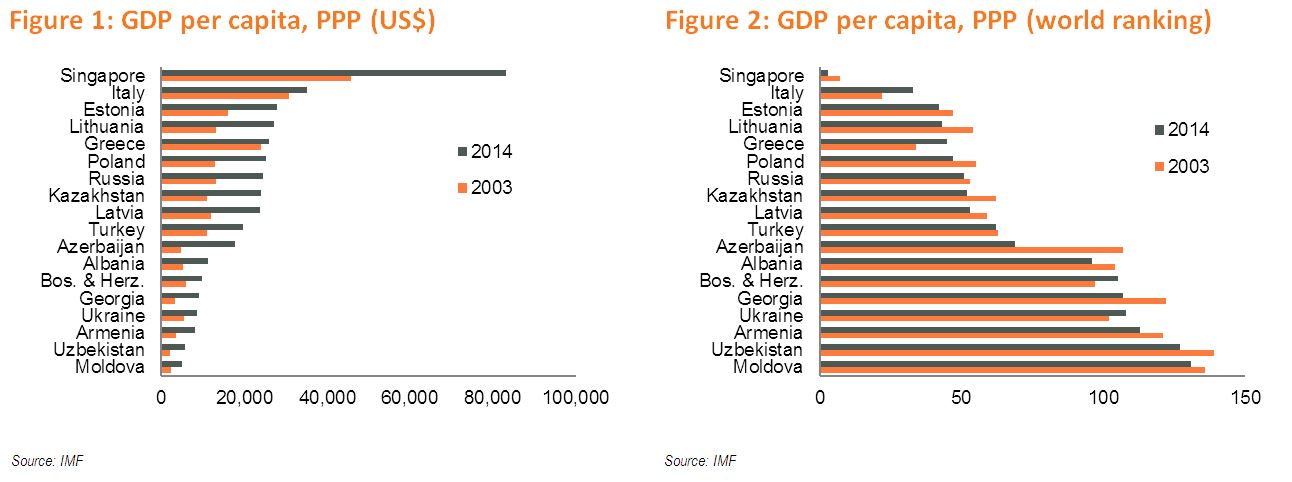Comparing Living Standards
Gross domestic product (GDP), the sum of all economic activity within a nation’s borders, provides a good snapshot of a country’s economic performance. However, citizens of a country with a large GDP do not necessarily live better than those in smaller economies, as GDP per capita is the better indicator of a nation’s standard of living. For Example, China is the second largest economy by size of GDP after USA, but there is still a sizeable gap in the quality of life of an average American and an average Chinese citizen, captured by per capita GDP, as China has the world’s largest population. In our case, Uzbekistan’s GDP at US$ 62.6bn in 2014 was almost 4 times larger than that of Georgia, but the average quality of life of a Georgian citizen was higher than that of an Uzbek citizen, as measured by per capita GDP. On average, a citizen of Uzbekistan (with per capita GDP at US$ 2,046) had less money than a citizen of Georgia (per capita GDP at US$ 4,434), with the Uzbek population 8 times larger than the Georgian population. As seen above, national output statistics are commonly converted into US$ for comparison reasons across countries. However, there are two main methods of making cross-country comparisons of GDP and the related per-capita income and they can provide markedly different answers.
Two different yardsticks:
1. Per capita GDP
When determining individual economic wellbeing, GDP per capita is a more appropriate tool than GDP. To arrive at this figure, the market exchange rate is used to convert GDP in national currency into US$. Using this metric, Georgia’s per capita GDP has shown remarkable improvement, increasing almost 5 times to US$ 4,434 in 2014 from US$ 924 in 2003, helped by healthy GDP growth rates, as well as a decrease in population. However, the recent regional economic problems and related lari depreciation have weighed on per capita GDP, bringing it to almost the 2011 level. According to IMF’s estimates for 2015, Georgia ranks 119th out of 189 economies in terms of GDP at US$ 13.8bn and 117th in terms of per capita GDP at US$ 3,720. To reverse the trend, the value of goods and services that we produce must increase significantly. If Georgia wants to join the ranks of countries with US$ 10,000 GDP per capita by the mid-2020s, it will need average annual real growth of at least 6%, which would allow Georgian citizens to feel the benefits of economic growth through improved living standards. To achieve this level of per capita income, FDI is one of the most important factors, taking into consideration Georgia’s low savings rate and skills needed to produce more sophisticated goods and services. In this regard, government policies aimed at improving the business environment, coupled with increasing the competitiveness of Georgian products and services, are essential.
2. GDP per capita based on PPP
An even better indicator for comparing living standards across countries is GDP per capita based on purchasing power parity (PPP), which takes into account variations in living costs across nations. Instead of market exchange rates, this metric uses the PPP exchange rates, which show how much currency will be needed to buy the same quantity of goods and services in different countries and is a more accurate reflection of actual living standards. This type of cross-country comparison is the basis for the well-known "Big Mac" index, which is published by the Economist magazine. The major advantage of PPP exchange rate is its relative stability over time compared to market rates. Another drawback of market exchange rates is that they are relevant only for internationally traded goods. Non-traded goods and services tend to be cheaper in low-income versus high-income countries. A haircut in Georgia is significantly cheaper than one in New York, as is the price of a taxi ride or a theatre ticket. Any analysis that fails to take into account these differences in the prices of non-traded goods across countries will underestimate the purchasing power of consumers in developing countries and, consequently, their welfare. For this reason, PPP-based per capita income is generally regarded as a better measure of overall individual well-being.

Using PPP-based per-capita GDP, Georgia was in 107th place with US$ 9,209 GDP per capita (PPP) in 2014, ahead of many developing countries, including many from the former soviet bloc: Armenia, Ukraine, Uzbekistan, twice as rich as Moldavians, more than three times wealthier than Tajiks, and significantly ahead of many developing Asian and African countries. Georgia is close to Bosnia and Herzegovina, Egypt, and Albania, but lags significantly behind rich countries, including major remitting countries for Georgia like Russia with per capita GDP (PPP) at US$ 24,449, Italy at US$ 35,131, and Greece at US$ 25,954.
While this outcome is disappointing, it is still an improvement compared to 2003, as Georgia moved up 15 spots in the global ranking over the last 11 years, becoming almost 3 times wealthier based on per capita GDP (PPP). This progress came on the back of higher growth in Georgia, compared to other economies, and structural improvements, which reduced living costs. While this number takes into account the decline in the Georgian population by 588,000 persons over that horizon, leaving the population number unchanged in 2014 still yields a more than 2x increase in PPP-based per capita GDP since 2003. Notably, while lari depreciation weighs on the per capita GDP estimate for 2015, in PPP terms Georgia still posts an improvement over the 2014 figure, according to IMF. Based on IMF’s projections, Georgia will maintain the same position in the global ranking with projected annual average real growth of 4.6% over 2016-2020. Faster growth will be necessary to move up in the global per capita GDP ranking and improve the country’s living standards.
Looking at the prospects of Georgians’ living standards, a stronger lari will translate into higher GDP in US$ terms, bringing Georgia closer to the club of wealthier nations. Maintaining a competitive environment and an open economy is imperative to keep living costs manageable, so that the higher GDP per capita in US$ terms will translate into higher GDP per capita based on PPP.
Eva Bochorishvili (Galt and Taggart)











